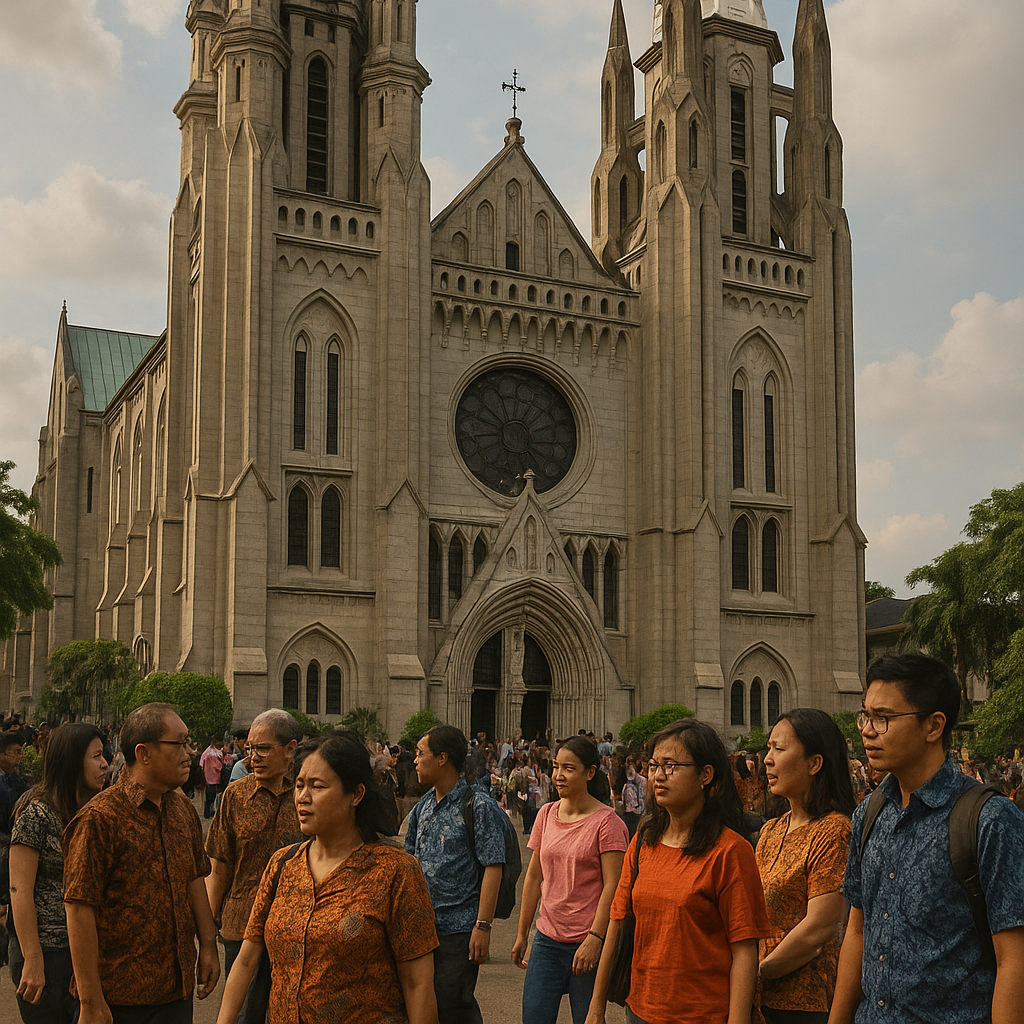The Development of Christianity in the Bahau Region, East Kalimantan: History, Challenges, and Acculturation
theolingua.id – The Bahau region is located in the interior of East Kalimantan. It is inhabited by Dayak Kenyah and Dayak Bahau communities. Geographically, the Bahau region has a landscape dominated by tropical rainforests, mountains, and the Bahau River, which is the lifeblood of the local community. Infrastructure in the region is still limited, with access to transportation depending more on river routes and roads that are not yet fully developed.
The Bahau people traditionally have a strong social and cultural system, with customs that are passed down from generation to generation. The traditional lamin house, carvings, and traditional ceremonies such as the pelas tanah (a ritual of respect for ancestral spirits) are still part of everyday life. Before the introduction of Christianity, the Bahau people adhered to animistic and dynamistic beliefs that believed in the power of ancestral spirits and the existence of ethereal beings that dwelled in the natural environment.
The development of Christianity in Bahau has high academic and social significance. From a historical perspective, the entry of Christianity brought major changes to the social structure and belief system of the Bahau community. However, so far, studies on how Christianity developed, the challenges faced, and its interaction with local culture are still very limited.
Socially, understanding the journey of Christianity in Bahau can provide insight into the dynamics of religious and cultural diversity in Indonesia. With a deep understanding of the development of Christianity in Bahau, we can also reveal how local communities adapt the teachings of a new religion to the customs and traditions they have embraced for centuries. In addition, with the growing development of modernisation and globalisation, it is important to see how the church and Christian communities in Bahau adapt to changing times without losing their cultural identity.
The interaction between Christianity and local culture in Bahau is an interesting phenomenon to study. Since the arrival of Christianity in this region, there has been a significant process of acculturation between religious teachings and local customs. Although many people have embraced Christianity, traditional cultural elements are still preserved in everyday life.
One form of interaction that can be seen is in religious ceremonies, where some churches continue to accommodate elements of local culture, such as the use of local languages in worship and the inclusion of traditional art elements in church music. In addition, the concept of togetherness in the community, which is an important value in Dayak culture, continues to be adapted in the life of the Christian congregation, for example through mutual cooperation in building churches or supporting community members who are experiencing difficulties.
However, it is undeniable that the interaction between Christianity and local culture also faces challenges. Some traditional practices related to animistic beliefs, such as the ritual of summoning ancestral spirits or the use of amulets, sometimes contradict Christian teachings. This has led to debate among the community about the extent to which traditions can be maintained without violating the principles of their new religion.
In practical terms, this information can be a reference for religious leaders, the government, and social organisations in developing strategies for the harmonisation of religion and culture. This study can also help to understand the challenges faced by Christian communities in rural areas and formulate more inclusive policies in social and religious development.
The History of the Entry of Christianity in Bahau, East Kalimantan
The entry of Christianity into the Bahau area of East Kalimantan was part of a wave of Christian missions that developed in the interior of Kalimantan from the end of the 19th century to the beginning of the 20th century. Before the arrival of the missionaries, the Bahau people, who were mostly from the Dayak Kenyah and Dayak Bahau tribes, adhered to animistic and dynamistic beliefs. They believe that the universe is inhabited by ancestral spirits and spirits that have a major influence on human life.
The spread of Christianity in Bahau began with the arrival of missionaries from various evangelising institutions, both from Europe and local mission organisations. One missionary group that played an important role were evangelists from the Netherlands and Germany who were members of the Rheinische Missiongesellschaft (RMG) as well as missionaries who were members of the Christian and Missionary Alliance (CMA). They began to explore the interior of Kalimantan, including the Bahau area, with the aim of spreading Christianity to the Dayak tribes.
In the beginning, the efforts to spread Christianity did not go smoothly. The main obstacles faced by the missionaries were language, strong customs, and limited access to transportation to the interior. However, with a social and educational approach, the missionaries succeeded in attracting the attention of the local community. They set up schools and simple health centres aimed at improving people’s standard of living. Education became the main tool in introducing Christianity to the younger generation, who then played a role as intermediaries in spreading the religion to their communities.
The Bahau community’s acceptance of Christianity did not happen instantly, but rather through a long and challenging process. At that time, the Dayak Bahau community faced various challenges such as inter-tribal warfare, disease outbreaks, and pressure from Dutch colonialism. In this situation of uncertainty, Christianity offered hope and an appealing spiritual solution to the local community.
Although Christian teachings are different from the animistic beliefs previously embraced, there are some similarities in values that make this religion more easily accepted. For example, the concepts of togetherness, solidarity, and compassion in Christian teachings are in line with Dayak traditional values that uphold mutual cooperation and social harmony.
As the influence of Christianity spread, some traditional leaders and tribal chiefs who had embraced this religion also played a role in its spread. They acted as intermediaries between the missionaries and the local community, explaining Christian teachings in a way that was easier for their community to understand.
After Christianity began to be accepted, small churches began to appear in the Bahau region. Initially, worship was carried out simply in people’s homes or simple wooden buildings that were used as churches. However, as time went by, permanent churches began to be built, and some of them are still standing today as a testament to the history of Christianity in the area.
In addition to the church, the Christian community in Bahau is also active in various social activities, such as education, sustainable agriculture, and community-based economic development programmes. These activities help strengthen the position of Christianity in people’s lives and ensure that Christian values remain relevant in everyday life.
The Development of Christianity over Time in Bahau, East Kalimantan
From the introduction of Christianity to the Bahau region of East Kalimantan in the late 19th to early 20th centuries, its development has been dynamic, influenced by various social, political, and cultural factors. From the initial spread by missionaries to the role of the church in modern society, the journey of Christianity in this region reflects a complex process of adaptation to changing times.
During this period, Christianity began to develop more rapidly as the number of its followers increased. Community involvement in religious activities also increased. One factor that accelerated the growth of Christianity was the Indonesian government’s policy of supporting the formation of formal religious institutions. In addition, increased access to education and modernisation in East Kalimantan encouraged more and more Bahau people to embrace Christianity.
Today, the church is not only a centre of worship, but also an educational and social centre. In addition, many local leaders who have received a Christian education play an active role in spreading this teaching to their communities.
The advent of the reform era in Indonesia brought about various social and political changes that also influenced the development of Christianity in Bahau. On the one hand, freedom of religion was strengthened, giving churches and religious organisations more room to grow. On the other hand, the flow of globalisation and migration of people from outside the region began to bring its own challenges in maintaining the identity of the Christian community in Bahau.
In this period, the church faced new challenges, such as the influence of modern culture, urbanisation, and wider interaction with other religions and beliefs. Nevertheless, the Christian community in Bahau has maintained its role in society through various social and economic programmes, such as the construction of Christian schools, health services, and church-based community economic empowerment.
Obstacles to the Spread and Development of Christianity in Bahau, East Kalimantan
In the process of spreading and developing Christianity in Bahau, East Kalimantan, there are various obstacles faced by missionaries, church leaders, and the local Christian community. These obstacles do not only come from external factors, such as geographical and social conditions, but also from internal challenges within the church itself.
Bahau is an area with challenging geographical conditions, with many areas that are still remote and difficult to reach. This factor was one of the main obstacles to the spread of Christianity, especially in the early days of its arrival.
In the early days of the spread of Christianity, transport to the interior of East Kalimantan was still very limited. Missionaries had to cross large rivers, dense forests, and difficult terrain to reach the Dayak Bahau tribal community. Until now, despite improvements in infrastructure, some areas are still difficult to reach, so church services and the spread of Christianity continue to face obstacles.
Limited facilities such as electricity, communication networks, and transportation make the development of the church and Christian education in this area slower than in other more developed areas.
Initially, some people rejected Christianity because it was seen as a threat to traditions and customs that had been passed down from generation to generation. Some traditional rituals and local beliefs were considered to be contrary to Christian teachings, causing tension between followers of the new religion and people who still upheld ancestral traditions.
Although there has been acculturation between Dayak culture and Christianity, there are still a number of community groups who are hesitant to completely abandon their traditions. The church must find a way for Christianity to be accepted without losing the cultural identity of the local community.
In addition to these limitations, in its development, Christianity in Bahau must also deal with the growing influence of other religions in the region. With increasing access to the outside world, the influx of other religions is also increasing. This poses a challenge in keeping the Christian community solid amid increasing religious diversity.
High population mobility, both from within and outside the region, has led to greater interaction between Christians and followers of other religions. While this encourages interfaith dialogue, on the other hand, the church must try to keep Christian teachings relevant to younger generations who are more open to new religious and cultural influences.
The shortage of local pastors and church leaders is also a major challenge for the development of Christianity in Bahau. This is compounded by the large number of young people who choose to move to big cities to continue their education or find work, so that the regeneration of church leaders in this area is hampered. In addition, the limited number of theological education institutions in the Bahau region means that many prospective church leaders have to study outside the region. Not all of them return to serve in their hometowns after completing their education, so the church often experiences a shortage of qualified ministers.
Furthermore, technological developments and the flow of globalisation have brought about changes in people’s mindsets and lifestyles that influence the way they view religion. Young people who are exposed to modern lifestyles tend to have a more flexible understanding of religion than previous generations. This poses a challenge for the church in maintaining traditional Christian values in the midst of rapid social change. Although digital technology can be an effective tool for the spread of religion, churches in the Bahau area have not fully utilised digital media to reach out to the people, especially the younger generation.
The last factor that cannot be ignored is the economic factor. The economic factor is also an obstacle to the development of Christianity in the Bahau region. Churches in Bahau still depend on donations and assistance from religious organisations outside the region. Funding limitations often hamper the construction of churches, Christian educational facilities, and social programmes oriented towards the welfare of the community. The lack of employment opportunities in the area also forces many residents to work outside the region. This has caused the remaining Christian community in Bahau to shrink, forcing the church to work harder to maintain its presence.
The Acculturation of Christianity with Local Culture in Bahau, East Kalimantan
The acculturation of Christianity and local culture in Bahau, East Kalimantan, is a long process that continues to evolve in line with the social and religious dynamics of the local community. Since the introduction of Christianity to the region, there have been various adjustments between Christian teachings and the traditions and local wisdom of the Bahau Dayak community. This acculturation is evident in various aspects of life, from religious rites, art and culture, to the social life of the community.
One of the most clearly visible forms of acculturation is the adjustment in religious rituals. For example, in Christmas or Easter celebrations, people often incorporate traditional music as part of church celebrations. The church has also adopted traditional symbols in its decorations and worship practices to be more in tune with the local culture. Not only that, but most communities retain some traditional elements in funeral processions, such as the use of Bahau woven cloth as a shroud and traditional ceremonies before or after the funeral service.
Another form of acculturation has also occurred in church art and music. Music and dance are an important part of Bahau Dayak culture. Along with the development of Christianity, there has been a fusion of church music with traditional musical instruments and singing styles. Some churches in Bahau use traditional musical instruments such as the sape’ (a Dayak string instrument) in their services. This creates a worship atmosphere that is closer to the local cultural identity, while preserving the Dayak musical art.
In addition to using traditional musical instruments, some hymns are also sung in the Bahau Dayak language or use melodies typical of the area. This provides a more profound spiritual experience for the congregation, as they can worship in a more familiar language and musical style.
Church buildings in Bahau also show the influence of local culture in the design and ornaments used. Some churches in Bahau are built by adapting the shape of traditional Dayak houses, such as high roofs and the use of distinctive wooden materials. Traditional carved ornaments are also often found on church doors or altars as a form of respect for local art and culture. In some churches, there are traditional symbols combined with Christian elements. For example, Dayak carvings decorating crosses or church altars reflect the harmony between the new faith and the old cultural heritage.
In addition to worship, acculturation also occurs in people’s social lives. The values of mutual cooperation and togetherness that have long been part of Dayak culture are maintained in the Christian community in Bahau. The church is often the centre of social activities involving all members of the community, such as the construction of places of worship, social service activities, and religious celebrations involving the entire community.
In some cases of interfaith marriages, especially between Christians and followers of indigenous beliefs or other religions, adjustments are made to respect both traditions. Wedding ceremonies often involve a traditional procession first, followed by a church blessing as a form of harmonious acculturation.
The acculturation between Christianity and local culture in Bahau shows that religion can develop without having to erase the pre-existing cultural identity. These forms of acculturation occur in various aspects of life, from religious rituals, art, architecture, social life, to education.
Despite the challenges of this adjustment process, the Christian community in Bahau has succeeded in creating harmony between religious teachings and local traditions. As such, Christianity is not only part of people’s spiritual lives, but also enriches the local culture, creating a unique identity that combines the values of faith and the cultural heritage of the Dayak Bahau.








